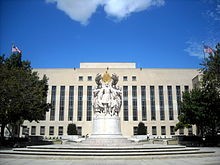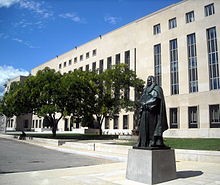E. Barrett Prettyman Courthouse
Introduction
Text-to-speech Audio
Images
Front of the E. Barrett Prettyman Courthouse.

South side of the E. Barrett Prettyman Courthouse.

Backstory and Context
Text-to-speech Audio
The courthouse was built on Reservation 10, a site bounded by Constitution Avenue, Third Street, C Street and John Marshall Place. The building faces south across Constitution Avenue towards the Mall, and was erected on the northwest quadrant of its site. This placement accommodated driveways along the south and west facades, and along with the subsequent plazas and landscaping, provided a buffer between the colonnades of the E. Barrett Prettyman Federal Courthouse and the verdant Mall, onto which it opened before I.M Pei's 1970 addition to the National Gallery.
With construction starting in 1949, the E. Barrett Prettyman Federal Courthouse was the last addition to a neighborhood of important civic and municipal structures. Known as the Municipal Center, this neighborhood's history of civic activity dates to the 1820 completion of George Hadfield's Old City Hall. In 1932, a formal plan for a Municipal Center, bounded by Constitution Avenue and G Street between 3rd and 6th streets, was designed. By 1934, municipal, police, and juvenile courts had been built on the site; however, the current site of the E. Barrett Prettyman Federal Courthouse was left vacant due to budgetary concerns. The site was used as a parking lot until 1949 when construction on the E. Barrett Prettyman Federal Courthouse commenced on the south eastern corner of the Municipal Center site.
One contemporary writer labeled the building "a rather conservative version of modern architecture in order not the conflict with the traditional architecture of the other buildings on the Federal Triangle." Chief Justice Harold M. Stephens' comment recounted a fundamental element of modernism: "We wanted the building to be functional, not monumental." As a dual classical/modern expression, the building remains a period work, and evidences the federal government's search for new architectural identities in the wake of the Great Depression and the Second World War.
